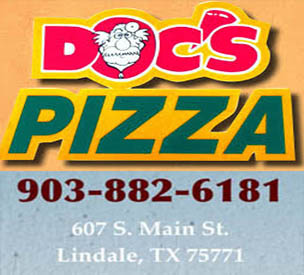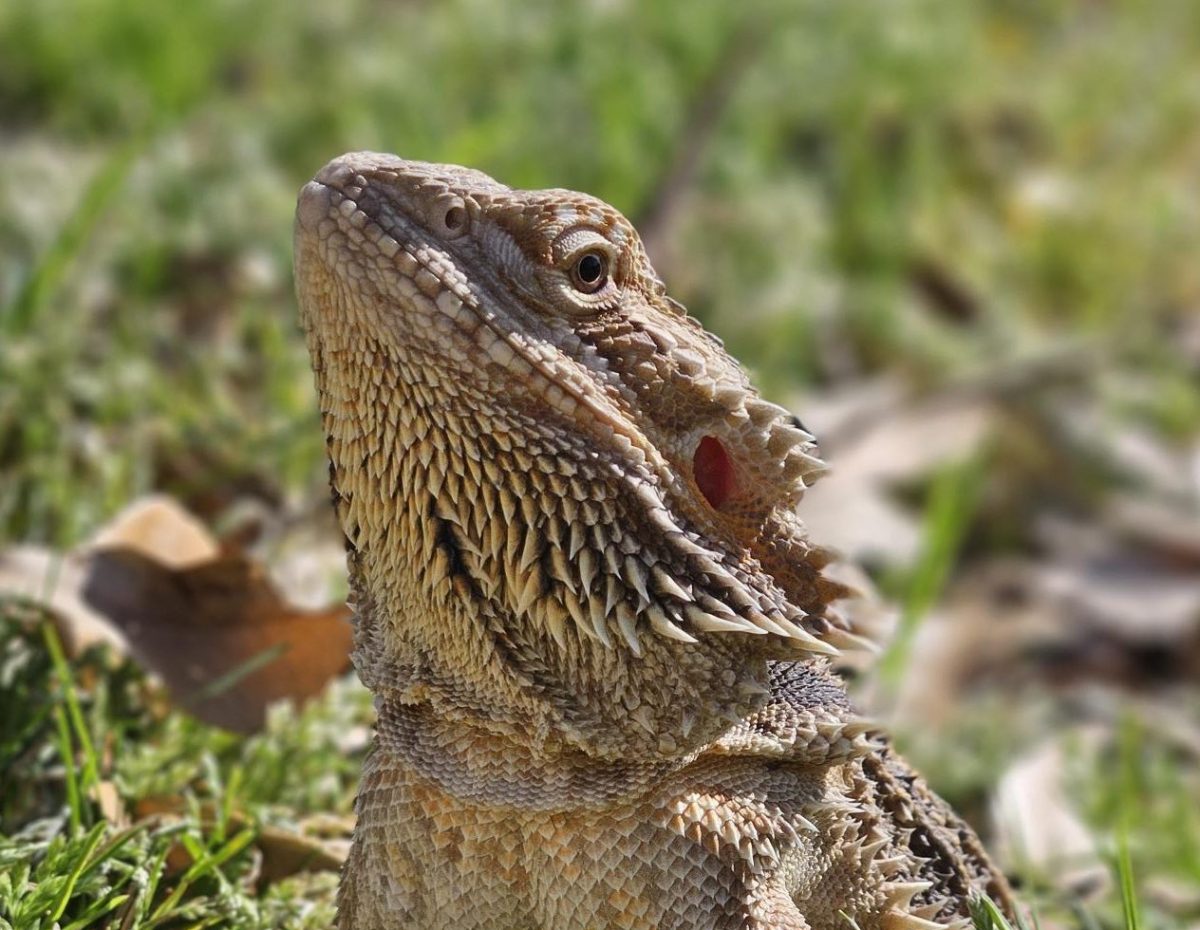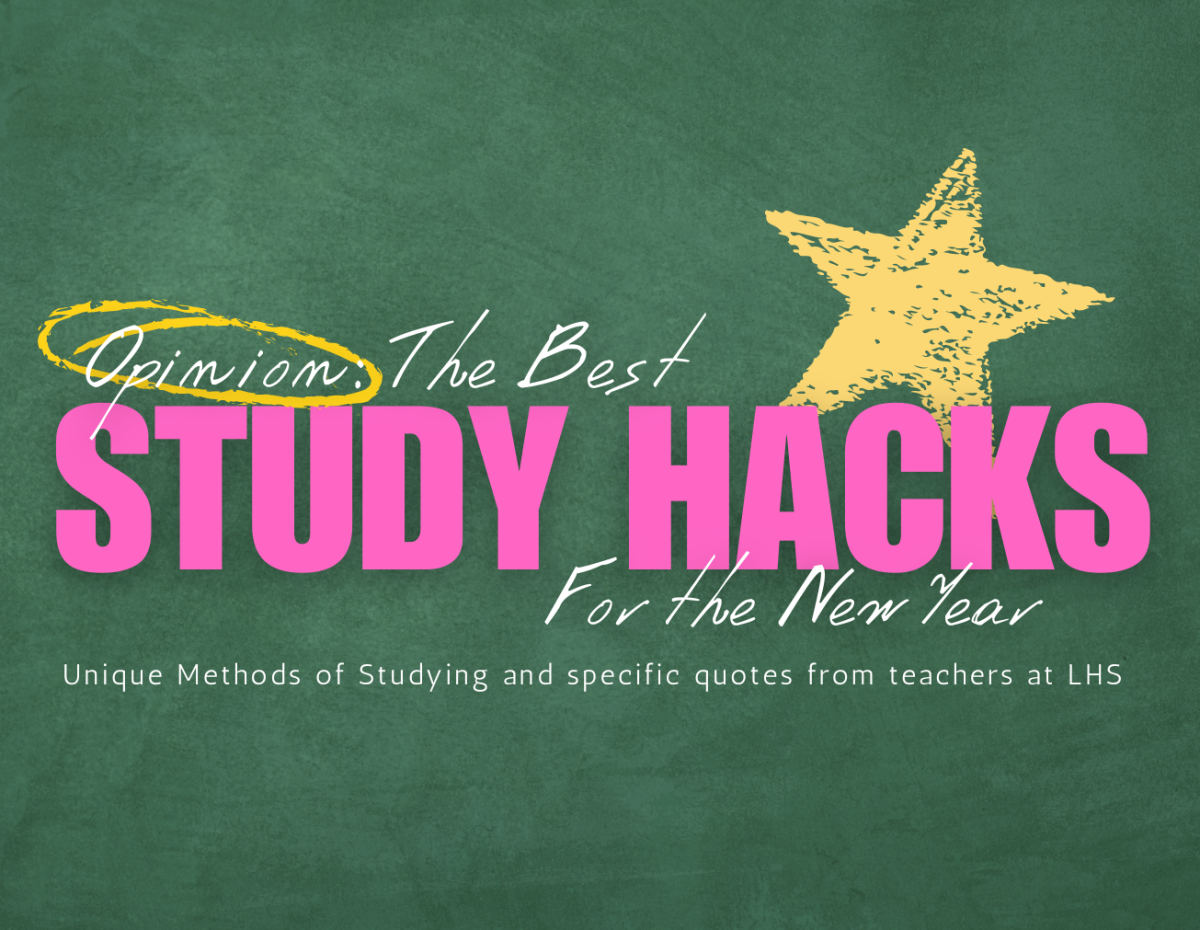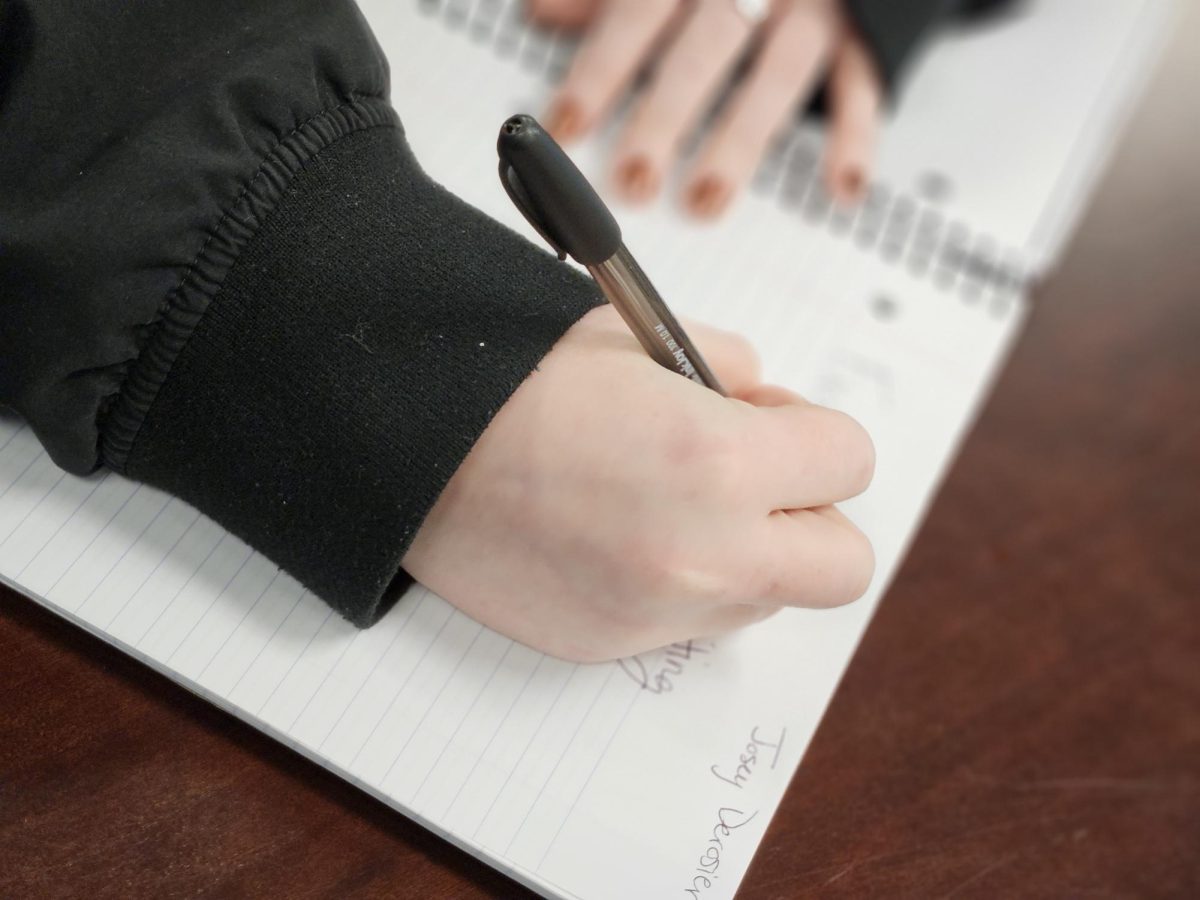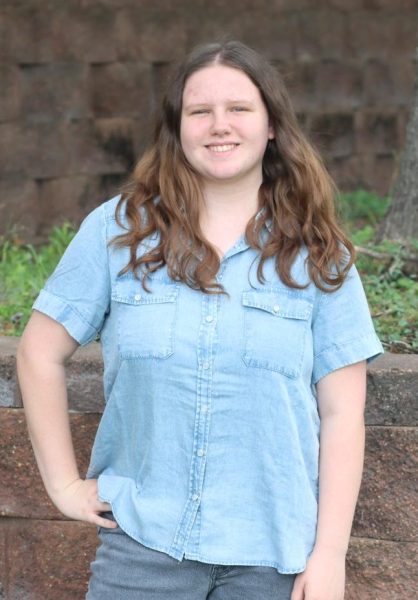America is filled with famous skylines all over its lands that are easily recognizable. From coast to coast, border to border, names like New York or Los Vegas are not uncommon. Each city is filled with unique attractions and, although not too far away, have a divers and wide range of the definition of ‘normal’. Though, some of the oldest of these great cities are along the east coast of the U.S.. Arguably the greatest of these cities is Philadelphia, Pennsylvania. From its towering skyline to its historic significance, Philly has something for everyone, and anyone. And this last week, I and my speech and debate team received the great opportunity to travel the city and compete at the University of Pennsylvania. Throughout the five days we were in the city, from Thursday Feb. 8 to Monday Feb. 12, we had a truly remarkable time and experience.
Thursday:
Thursday was the start of our great journey, and it started early. Early as in we had to be at the school on the bus at the 4 a.m.. The drive to the Dallas love field allowed most of us to sleep a little longer though, roughly two more hours. After getting through security, we boarded a southwest flight heading to Nashville, Tennessee at around 8 a.m.. After getting there, we switched flights, and were finally on a straight path towards Philly.
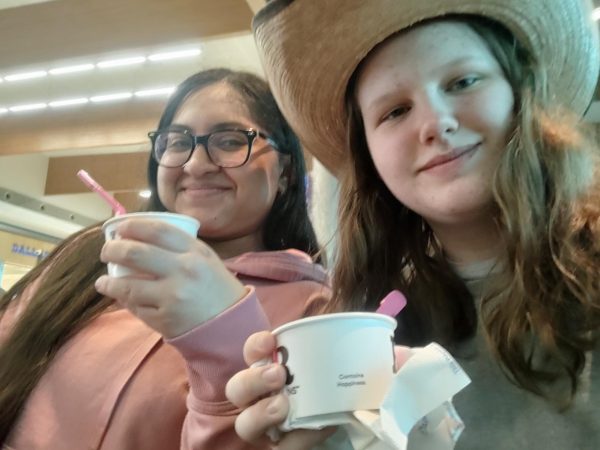
Upon entering the city, we got to take our first of many, train rides! This one was one of the cleanest we rode, but it has a strict no talking policy. After a short 10 or so minute ride, we entered the downtown area at Jefferson station. This is a major station in the downtown area, as it connects a major part of the suburb to the city. We also obtained Septa passes, which we would have to get every day since they are one day use only. These were our main mode of transportation along with buses. The whole trip we used public transportation to get everywhere.
Luckily, our hotel was only one street away from the entrance of the station, and we didn’t have to walk around with our luggage for too long. After getting our room keys, which took close to an hour, we finally got to our rooms on the 28th floor of the Loews Philadelphia Hotel in the City Centre. I and my roommate, junior Flor Mendez, were lucky and our window was on the side of the building that faced the majority of the city. The view was breathtaking, and I stood looking out our window for a good hour all together.
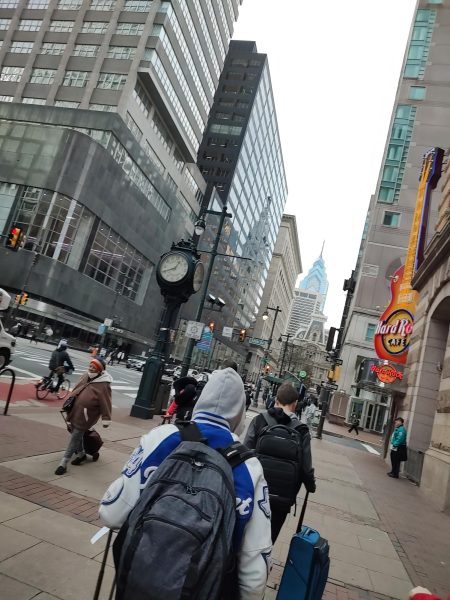
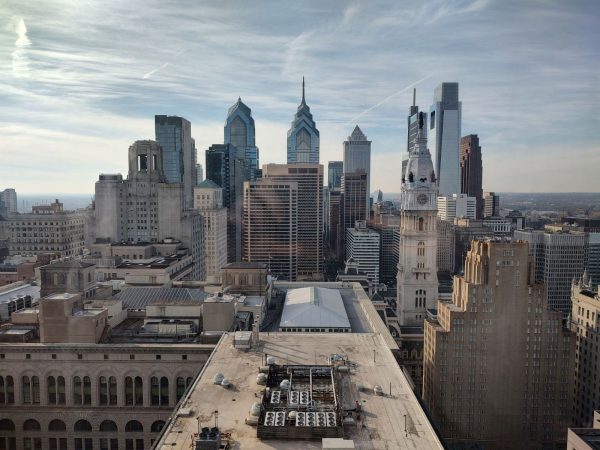
At around dinner time, our whole group met back up in the lobby and went out to the city to get some food. We traveled a good distance, traversing down a popular street. We eventually stopped at a Philly cheesesteak restaurant called Sonny’s. Philly is famous for their cheesesteaks, hence the name ‘Philly’ cheesesteak, and let me tell you, the restaurant did not disappoint. Afterwards we went to an old fashioned ice cream parlor called the Franklin Fountain where they make it the same way they did over 200 years ago when they opened. Afterwards, we went back to the hotel around 8ish, getting ready for the next day. The view from our window was even better at night.
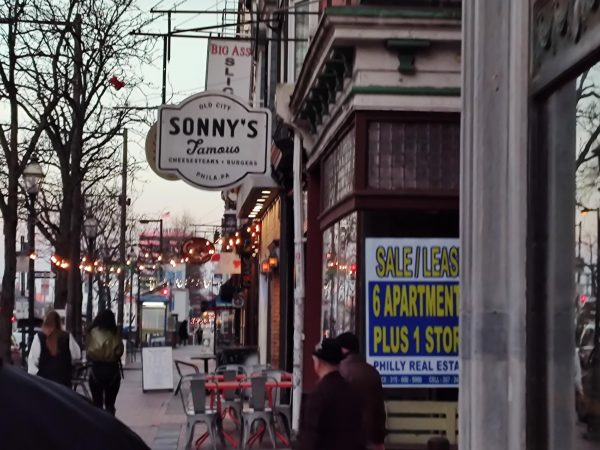
Friday:
Friday was our main day to sightsee everything we could about the city. We received special Go City Passes that allowed us to see a vast majority of the city’s main attractions, as well as bus passes for the Hop on Hop off bus. This bus ran in a loop around the main city area. It was also a double decker bus.
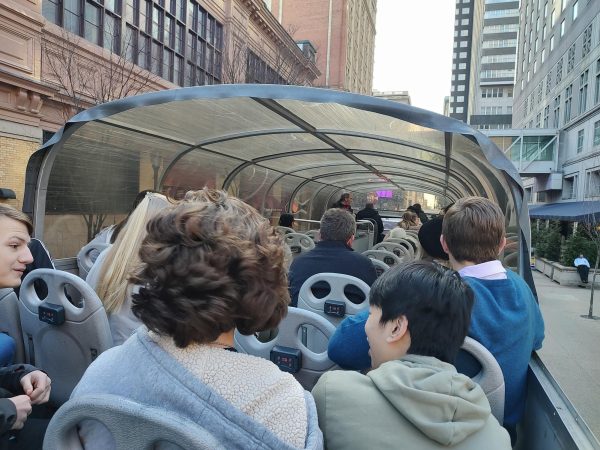
Our first attraction was the Eastern State Penitentiary Museum. It was an old prison, and the first penitentiary in America. The massive structure is a prison in an outer city part of Philadelphia as well as a very historic site today. The former Penitentiary was built with a medieval era look to it, though most of its features are just for show. The most important part of the prison is the massive wall that surrounds the property. From the outside the wall is a towering 50 feet up, an imposing force in the neighborhood. But from the inside, which was dug down another 10 feet, the wall is terrifying 60 feet tall. This wall made it virtually impossible for inmates to climb over it, and kept the entire prison very secure from both inside and outside.
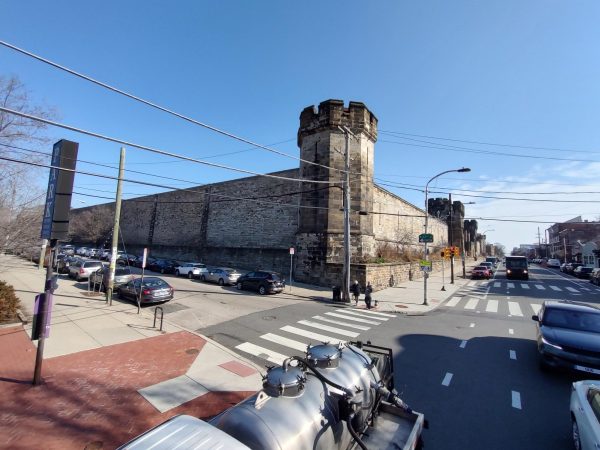
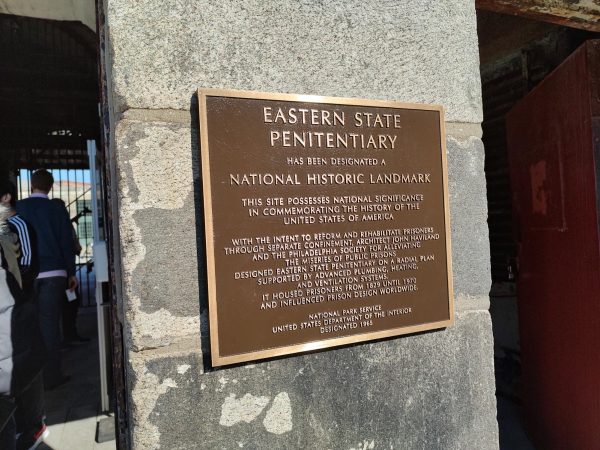
Contrary to its name, when the penitentiary opened in 1829, it was far from a place of redemption it was supposed to be, and an unspeakable number of horrors occurred in its once completely silent halls. The penitentiary, for the majority of its earlier years, believed that criminals needed to be in complete silence to repent and change the patterns of their actions. Inmates were put in almost 24 hour solitude, and when they did come outside of their cells, they were wrapped in cloth to protect their identities from other inmates and keep them from gaining any sense of direction in the Prison. The rooms they were kept in were small, usually only having a bed, desk, and small door to an outside area which has restricted usage. The prison cells were built to resemble a chapel on the top, a small window allowing light to penetrate through the otherwise windowless cage. In the earliest models of the prison, when they believed total silence and solitude was the best way to change people, only a small window-like door was accessible through the main hallways where food would be provided.
This later changed, and actual doors were added to the prison. Other additions were added to the original blueprints of the penitentiary. Some of the main hallways, known as cell blocks 1-8, gained a second story in order to add more prisoners. This was also around the time where the penitentiary’s system was known as the Philadelphia system. This type of prison became popular in large parts of the world, but also competed against the New York system, which thought making prisoners work in a better community inside the prison was the best way to change their actions. This competition for popularity of prison system was the main reason the penitentiary had so much historic relevance. Many of the practices invented there are still used today to some degree. The fact that the penitentiary was the first of its kind, and not dead set on simply punishing its inmates, is another reason it is so important and preserved as a museum.
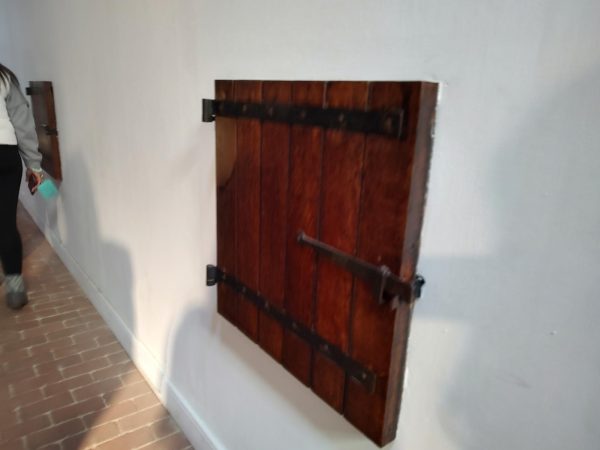
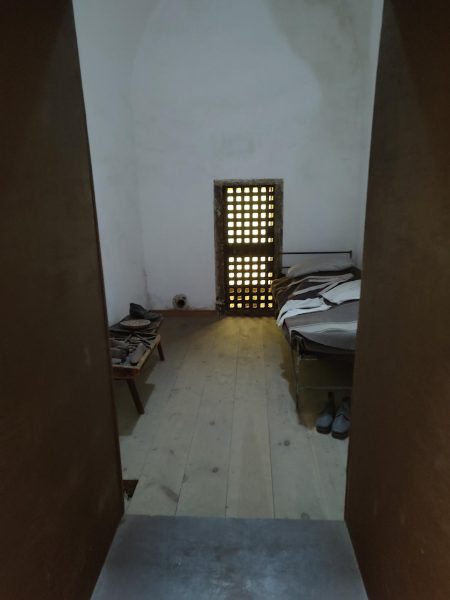
Some other facts about the penitentiary:
1) It only has one entrance and one exit, the front gates that can close just like a medieval castle.
2) The eighth cell block was later turned into a hospital ward, and remained as the only one on the property.
3) The sewage system was advanced for a structure that large, and many escape attempts were made through it. (Some were successful but at what cost?)
4) The prison did not have a very big problem with racism like others during its time did. Many prisoners documented how things simply changed one day and that was that.
5) Before the penitentiary was open, many criminals were simply thrown into a room together for holding. This was actually one of the main reasons why the city needed the prison in the first place. It also increased the need for some cell blocks to have multiple stories so they could hold more people.
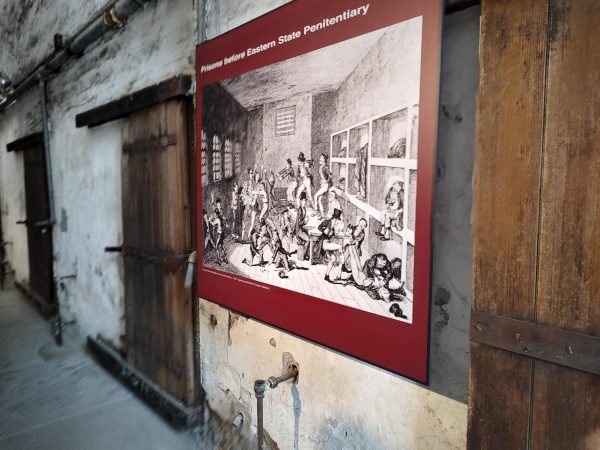
6) The prison has an iron plaque dedicated for inmates who served during the world wars. It would have been an honorable act had their names been added. In their place, their inmate numbers were placed instead.
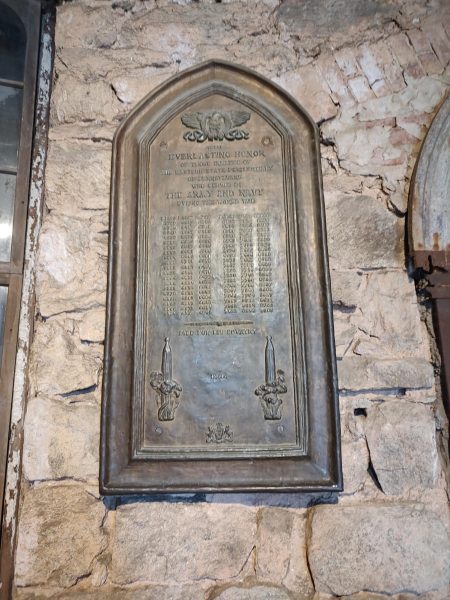
7) During the last few decades of the prison’s operation, guards were described as ‘lax’ with prisoners, and brutality rates in the prison were low. There are even stories of Christmases being held in tandem with guards and prisoners.
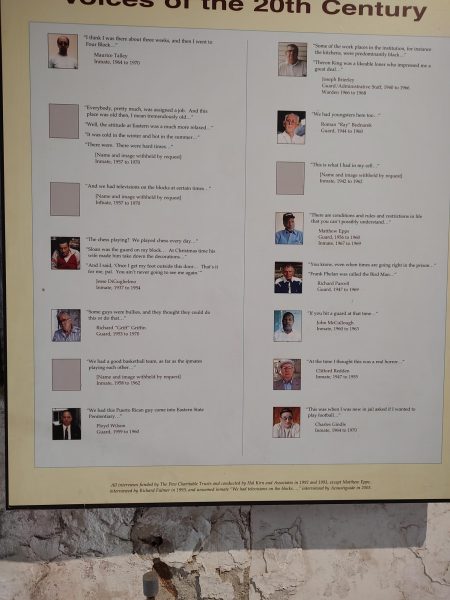
After touring the museum, we headed towards the Philadelphia Museum of Art. Although we did not enter the museum, we did take lots of pictures of the statues and famous skyline of the city. Some of these famous pictures were of the Rocky statue. We climbed the steps of the rocky too, leading up to the masterpiece of architecture that is the art museum. Fun fact, there are two flags waving near the entrance of the museum, the American flag and Philadelphia city flag. We also took pictures of the famous statue Eakins Oval. This statue holds a lot of symbolism, including George Washington on his war horse on the very top, and four smaller statues representing the four major rivers of Philadelphia. Each of the four smaller statues has an animal known to be native to North America, and holds significance to the US, as well as depictions of Native Americans, in honor of those who were here before us. On the street in front of the statue, there is a long line of flags. The city of Philadelphia sets up these flags from every nation in alphabetical order in honor of the many nationalities that call Philadelphia home. There are two exceptions to this odor, one being the Israeli flag and the Polish flag that asked to be moved to the outside entrance of the Holocaust Museum.
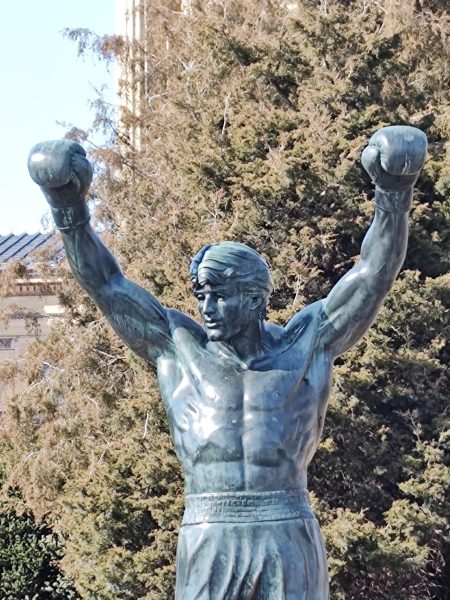
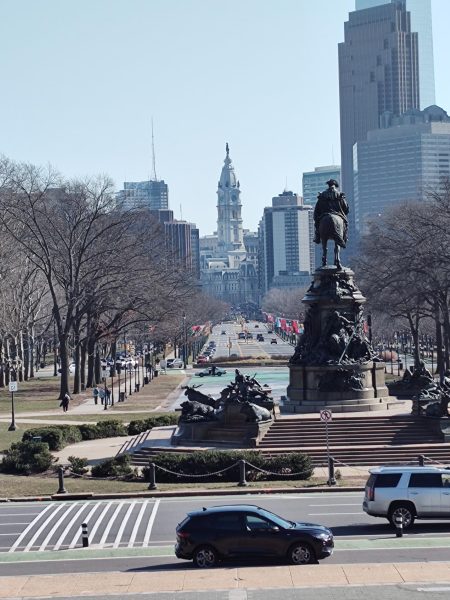
After this we took a tour bus to the other side of Philadelphia. This is where we saw the majority of the historic buildings, and ruins in one case. The first attraction we visited was the foundation of the original presidential mansion. This was the house that Washington, Adam, and Jefferson all lived in before the White House was built. The crumbling foundation holds the story of black Americans from hundreds of years ago, and the walls are a type of museum explaining the long road to the abolishment of slavery in the US. It is completely open to the public with no walls save for the patchy original of the building blocking it from the street. Across the street was the Liberty Bell. The museum that holds this is free entry, but a security check is mandatory. The Liberty Bell was surprisingly small to what I had imagined, but is very inspiring when face to face. The wood holding the bronze bell has not been changed since it became an attraction for the public.
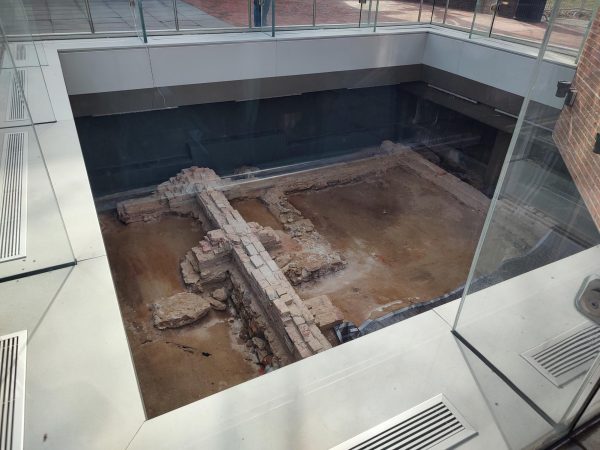
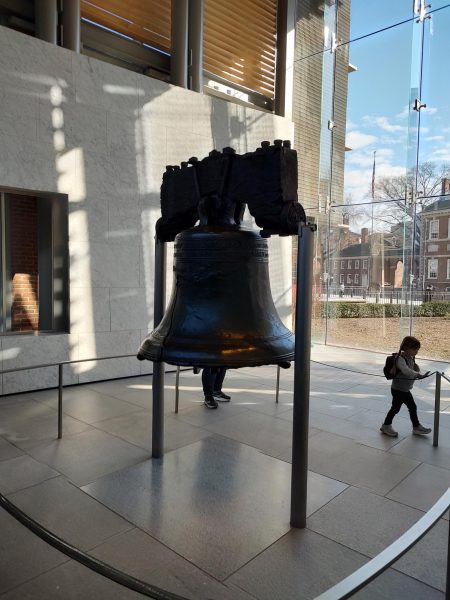
Once we were all done with the Liberty Bell, we then went across another street and went to Independence Hall. This is the building where the Declaration of Independence was penned and signed, the Articles of Confederation were ratified, and The Constitutional Convention was held as well as where The U.S. Constitution was ratified along with the Bill of Rights. The building used to be the capital building of Philadelphia, and all three branches of government, judicial, legislative, and executive, used to conduct business not 30 feet from each other. The capitol building has since moved locations, and the current building has been turned into a museum. It is also free of entry, and a Pennsylvania ranger conducts tours of the building in 30 minute intervals. You may not enter without the ranger. The lower level floors have been repurposed into close imitations of what it would have looked like almost 250 years ago when the country was founded. They do not claim to know 100% how anything looks nor if anything is authentic. The only piece of furniture they claim to be authentic is George Washington’s chair, which Benjamin Franklin has once written about. He had commented that he often wondered if the design on the top of the chair was a setting or rising sun. When they ratified the constitution, he finally decided it was a rising sun.
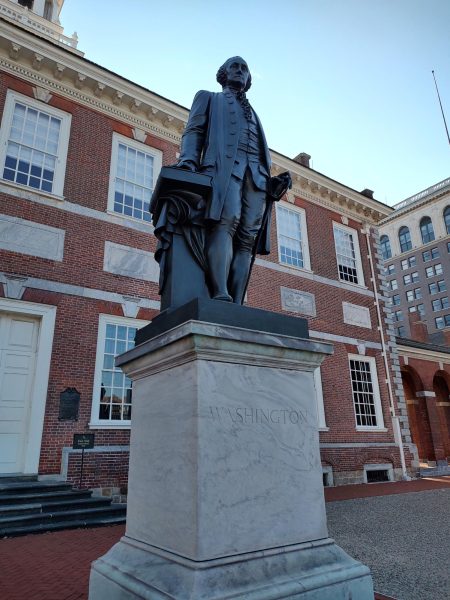
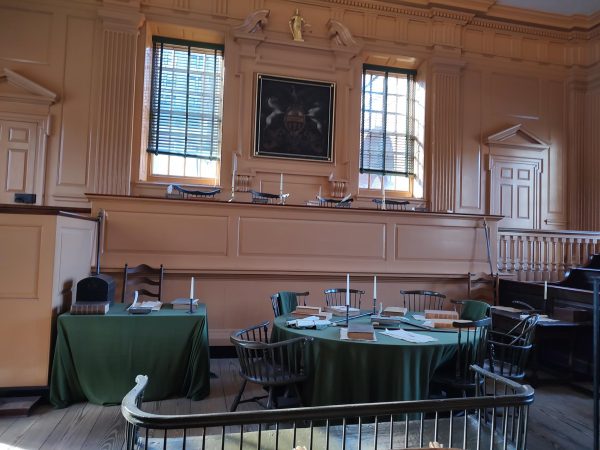
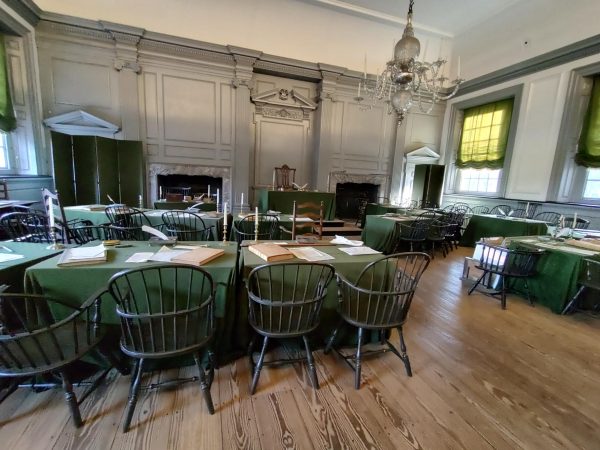
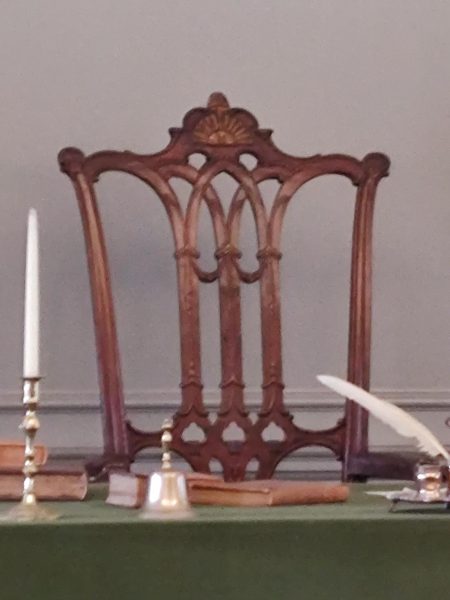
After this, I and other students who participated in Lincoln-Douglas, or LD, and Cross Examination, or CX, debate events had to split from the main group for debate rounds. We had two rounds of debate on Friday, and were done in the late hours of afternoon. We ate and traveled back to the hotel where we rested for a full tournament day Saturday.
Saturday:
On Saturday, we did no sight-seeing. We did, on the other hand, walk, or in more than one case run, across the University of Pennsylvania to get to our event rounds. The tournament was their 49 annual high school invitational. It was a stressful day full of crazy moments, but was fun nonetheless. Unfortunately, after a long day of working hard, no one on our team made it to finals on Sunday. This was a win-win situation for us though, seeing as if we made it to finals, well, we made it to finals. If we did not, then we got one extra day to explore Philadelphia before we left!
Sunday:
We left the hotel a little bit before lunch time and went down the street to a food court. This place was filled with all types of foods, drinks, and stores of every kind! There was a very wide variety of food choices, from Korean barbecue, seafood, to good old American barbecue. (I would not trust any kind of American barbecue that far north. They cooked their brisket in an oven and put no seasonings… It was not worth the $25 I paid for it.) Aside from the brisket fail, I also got a pretty good smoothie as well as an apple danish which was a 10/10.
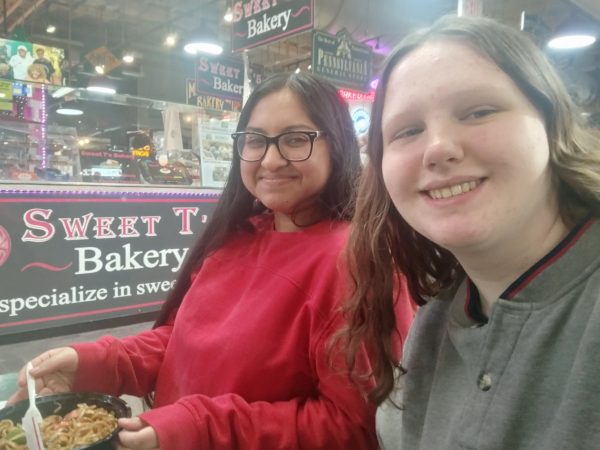
After this we traveled to the Franklin Institute of Science. This was an amazing experience, and there was so much to learn that in the four-ish hours we were there me and my friend only managed to get through two of the three floors. The entire building maintained an old architecture that resembled the Greeks style of architecture. There was also a massive statue of Benjamin Franklin at the entrance. While we were there, they had many small lesson shows. Here they would perform different lessons with many visual elements that taught everyone there, whether they were six or nearing 50 something new. Me and my friend in particular watched three shows the museum offered. One was a combustion show, which shows us how combustion occurs and many examples! The next one we saw was a cow eye dissection, and this taught us all the parts of an eye and how they work. The final show we saw was at the museum’s planetarium. This is a huge room with a projector that usually visualizes space. This particular show was about constellations, and how to identify them and how they can help with direction.
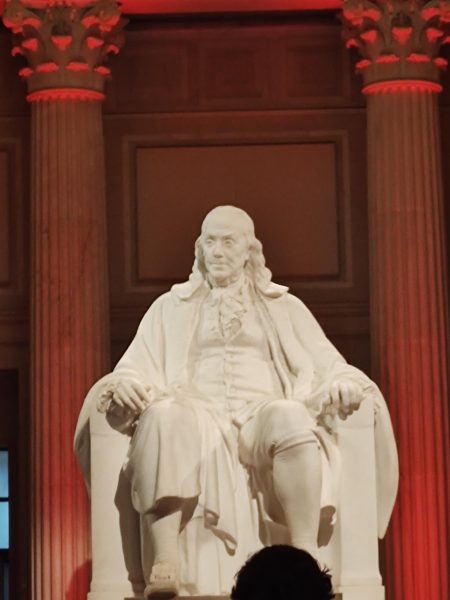
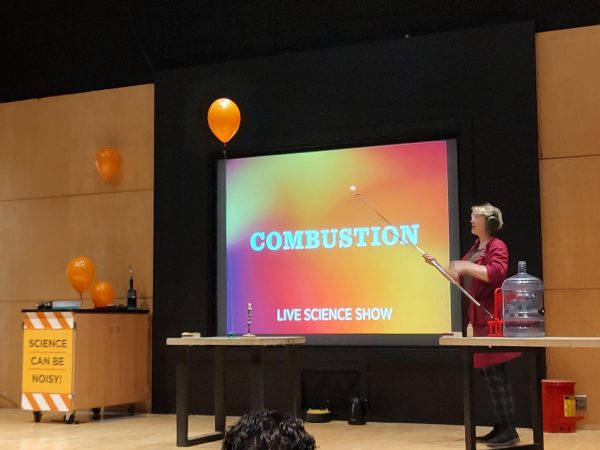
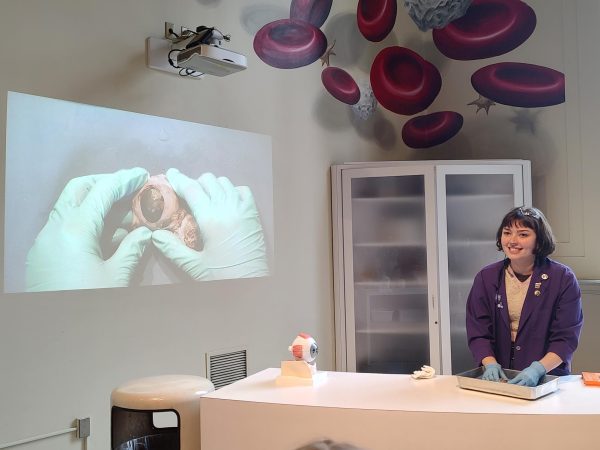
After this, we had little time to explore since our four hours were almost up. We headed back to the hotel, and got ready for dinner. This was the last dinner we would have in Philly, and our group went to Maggiano’s Little Italy, a fancy Italian restaurant. The food served to us came out all at once, and was pretty much a free for all but with polite order. While we were at the restaurant, the Super Bowl kicked, and everyone had a great time watching the first quarter or so there. Once we were done eating, we went back to the hotel and watched the rest of the Super Bowl. I began packing while watching, but got distracted very often. After the conclusion of the game, we finally tuned in for the night and prepared to wake up early the next day.
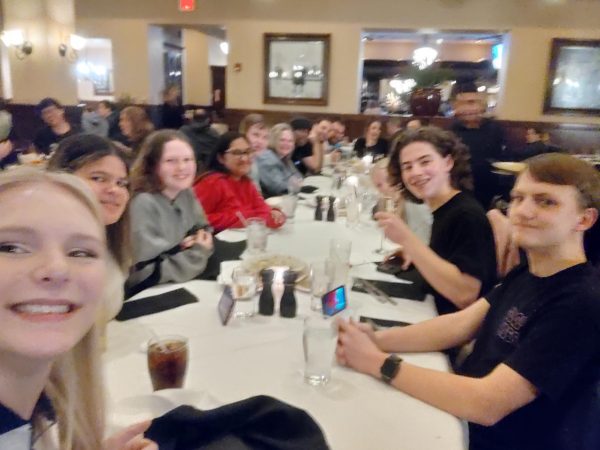
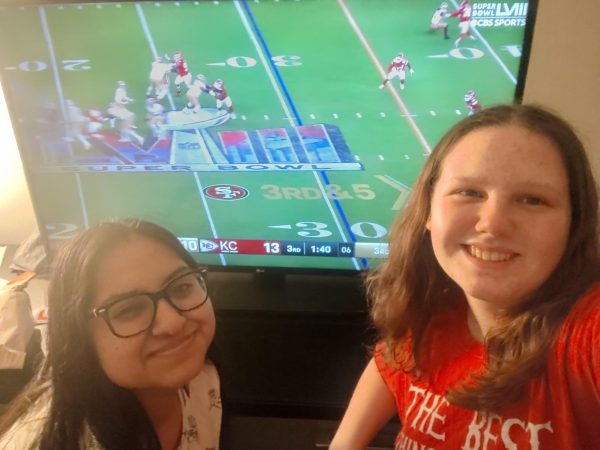
Monday:
We left the hotel Monday morning at around 5 a.m.. We took the same train that we took going away from the airport on Thursday to go back. Our flight left around 7:40, and was heading towards Atlanta, Georgia. We had a small layover there, and boarded our second plane soon after landing. We left for Dallas love field around 10:45, and landed a little after noon. We ate at the airport, then got on the bus to take us to the high school! And before we knew it, we were back home.
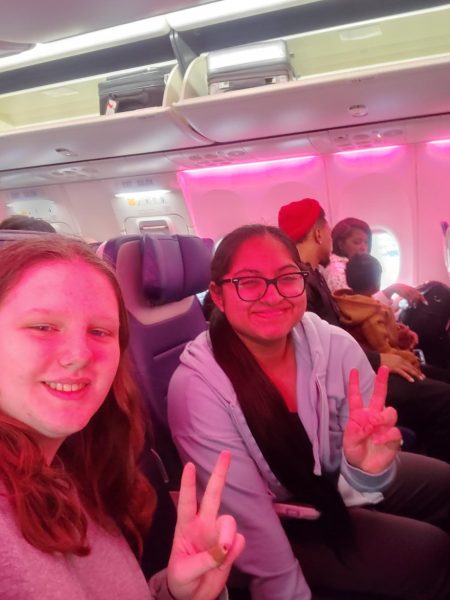
Overall, the trip to Philadelphia was amazing, and such an experience. I have never been in a city as big as Philly, and never been around such historic buildings either. From all the history I learned and got to see, to experiencing a small glimpse of city life, this trip was truly worth it.





